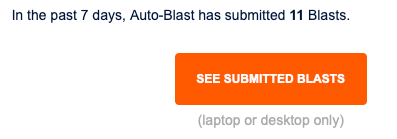 I like data. It helps make better decisions, and avoid posturing and hand-wavium.
I like data. It helps make better decisions, and avoid posturing and hand-wavium.
A bunch of people in the author community espouse the value of permafree* book one in a longer series. The basic argument is:
- There’s no friction to reader attachment, thus you’ll get a higher readership. This is testable.
- While less people as a percentage of book one readers will read next-in-series (as speculative “purchasers” can come from outside your genre lane), the volume of readers will drive greater success overall. We can test this for science. We can also talk about the shit-show of also-boughts and how that makes advertising painful.
- You gain exposure on other storefronts, other than the mighty Zon. We can test this too!
TL;DR: none of the promised gains worked for me, but I did see a massive spike in book 2 & 3 piracy. Let’s see how this happened.
* Permafree means a book that is permanently free, as opposed to a time-limited promotion. Amazon don’t generally allow permanently free books, but will often price match titles when free on other retailers like iBooks, Kobo, and Barnes & Noble.
The Method
I conducted two back-to-back 3-week tests with my Night’s Champion series. The first book released about eight years ago, and is well-loved by a lot of people; it has pretty good read-through (70%/50% books 2/3) despite initial hard fails of marketing (the back of these books until recently never mentioned they were a series, or where to get the next one. To those 70% and 50% readers respectively: I love your dedication).
- Night’s Favor was available on Amazon, iBooks, and Kobo (now on B&N, but not during the testing period).
- I advertised on BookBub (for iBooks and Kobo) and AMS (for Amazon). At the time, Facebook was doing weird shit with my ads, so I wanted to delete errors from the prospectus. The ad spend was about $10 per retailer, per day, for the permafree test. I dropped BookBub ads when the title returned to paid, and dropped the AMS spend to $5/day (I really want to see what kind of organic traction the other stores produce).
- Blasty was used to monitor available title uploads across various piracy sites.
- I used my ARC team and Booksprout to distribute review copies to garner social proof. I’m a Pro Author on Booksprout, providing watermarking in case of piracy, so we can see if copies came from that service. My ARC team are scrupulous about not distributing my works outside the huddle; I’ve never seen evidence of a single one sharing a read, except for my SiL giving my BiL an advanced copy that one time. We still need to talk about this.
- I monitored next-in-series purchases using the various dashboards on the retailers.
So, What Happened?
During the permafree run, something like 7,000 copies of Night’s Favor were downloaded across all stores. Most of these came from Amazon, where the book ranked in the top 10 for werewolves for a couple weeks. The book got a lot of downloads. I think we can say with confidence there was a decent sample size to test next-in-series sales.
During the Free Period
- I sold almost zero of books 2 and 3. Let’s call it 30 copies across all retailers. If you’re doing pocket math, you can probably see the ROI problems here. You can also work out the percentage of what 30 from 7,000 looks like.
- Amazon and BookBub gobbled my ad dollars like a heroin junkie on the needle. Amazon kept trying to get me to up my spend, because as it turns out ads offering free products do okay!
- Getting iBooks and Kobo readers to click your fucken ad is a nightmare. Them actually downloading it is harder still. Amazon customers seem more acclimated to free books, and/or my social proof on Amazon is greater. Who knows. Downloads for permafree on iBooks and Kobo dropped to zero (0!) after the ads stopped; those retailers appear to have poor discovery services at play.
- The overall ROI for this campaign was heavy negative according to my Readerlinks dashboard. I spent vastly more dollars shipping my book and “discovering readers” than I ever earned back in series sales. It’s not even close. Not the same ballpark. Not even the same sport. Probably not the same planet.
During the Paid Period
- I sold a continuous stream of books 2 and 3. While the numbers aren’t amazing ($5 ad spend a day, most of it unused!), it conformed to the 70/50 numbers I’d previously seen. I think it’s closer to 75 copies across all retailers during the three-week trial.
- Book 1 is $3.99 in the crowded urban fantasy/supernatural thriller genre, but maintained an almost-neutral ROI on its sales alone.
- This means books 2 & 3 sales were total profit, netting me positive ROI on spend.
- iBooks started selling organically on book 1, despite no ads driving readers to that storefront. Do Apple devalue free, or is some other algorithm at play? Who knows.
Analysis
Usual caveats about small sample size and selector bias apply.
I sent out an email to my readership mentioning my theory about free books languishing on Kindles the world over, and got a fair few emails in response with agreement. Readers collect free reads, but don’t prioritize the consumption of those books. It’s not about when, but if: they seem to leave free books on their ereaders for an age, and eventually delete them without reading. Even 99c presents a purchase barrier, meaning discount readers are more likely to read your book and then get the next in series. I think the mindset looks like this:
- Free: I’ll click and download, because free books are good! I probably won’t read it.
- Deep discount (e.g., 99c): If the cover is nice, and the page looks like it’s remotely me, I’ll give it a spin. I may nope out after a few chapters, but I might also get lucky.
- RRP: I will only buy this book if it looks like it’s in my lane. Conversion is much lower on book one, but books 2 & 3 are better.
There’s an interesting effect for also-boughts and algorithms too. Amazon particularly recommends books on “Customers who bought this also bought this other thing…” below the book details. Free books are wildly polluted by all manner of shit here. While careful ad crafting helps, your supernatural thriller might get also-boughts from, say, paranormal romance. Trust me when I tell you that a paranormal romance reader will get an … unexpected journey reading Night’s Favor.
There are some things that skew these views, such as incumbency. I believe there are successful authors making bank with book one of a series permafree, but they have such an established readership getting effective data is hard. I also believe some lower-rank authors get good traction with book one free (maybe a starved niche?), but it didn’t happen that way for me.
Having tested permafree, it appears to be a spectacular loss leader for ad spend and gaining readers. Our initial bullets and the results:
- Higher readership: nope. People don’t read the free books they have, and on retailers outside Amazon discoverability is miserable; you will pay, and keep paying, for every “sale” you make.
- Greater success overall: nope. I made 3-4x the revenue with a positive ROI on ad spend with book one as paid. I managed to give myself the gift of kack-fest also-boughts, meaning I’m now retraining Amazon’s AMS system for the right readers.
- Retailer exposure: hard fail. I only started selling books 2+ on iBooks after book 1 became paid. Kobo is a wasteland regardless.
What About Piracy?
Yeah, that’s what I opened with. Remember Blasty? I sure do.
This is a typical report from during and post the free period.

Yeah, I want to see those blasts. What do they look like?

HOLY SHITBALLS. It’s pages of people pirating book 2 in the series. That is, people got the first book for free, presumably read it, liked it, then went and pirated the everloving hell out of it. Not only did permafree not make me sales of books 2 and 3, it encouraged file sharing and piracy of those titles.
During the paid cycles, the results from Blasty are more measured, a smattering across my catalogue overall. It seems permafree readers feel entitled to keep reading a series for zero dollars, and will go out of their way to do so. Paid readers are far less likely, based on my admittedly small sample size, to do this: they’re accustomed to paying money for things. I dunno, maybe they had parents who taught them stealing was bad.
Where Did The Piracy Come From?
While extensive testing is fairly difficult if you have finite time (and my time is very finite), I couldn’t find evidence of Booksprout copies on pirate sites. They appear to be from Kobo and Amazon. While there are more Amazon copies in the wild, the distribution feels roughly right based on initial downloads; I don’t think one retailer’s customers are more likely to be thieves than another.
I think this exposes a mindset rather than customer base.
What Does All This Mean?
For you? Dunno. But for me, it means permafree is not a good idea. It doesn’t solve any of the challenges I have, all while increasing piracy of my catalogue. This doesn’t sound like winning!
If you’re a permafree author and having success, I’d love to hear from you about how. Data-driven specifics, not, “Umm, I think…” I’d especially like to hear how your back-to-back testing’s gone between free and paid, because I haven’t seen much evidence of that.
And now, back to you.
Discover more from Parrydox
Subscribe to get the latest posts sent to your email.
It’s probably worth leaving this here. It’s an oldie, but a good one: http://maggie-stiefvater.tumblr.com/post/166952028861/ive-decided-to-tell-you-guys-a-story-about
Also, of interest: https://www.theguardian.com/books/2017/nov/06/pirated-ebooks-threaten-future-of-serial-novels-warn-authors-maggie-stiefvater